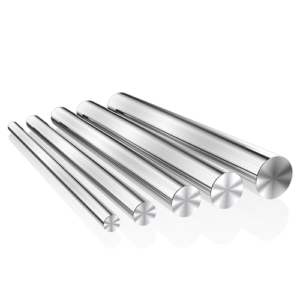Introduction

Stainless steel bars are ubiquitous in various industries, prized for their exceptional properties and versatility. From construction to manufacturing, these bars play a crucial role in ensuring structural integrity and performance. In this comprehensive guide, we delve into the diverse applications and attributes of stainless steel bars, highlighting their significance in modern engineering.
Understanding Stainless Steel Bars
Stainless steel are indispensable components in various industries, valued for their remarkable properties that stem from the alloy’s composition. Primarily composed of iron, stainless steel incorporate chromium, nickel, and other alloying elements in varying proportions to achieve specific characteristics.
Chromium, typically present in stainless steel at levels of at least 10.5%, forms a thin, passive oxide layer on the surface of the material. This oxide layer acts as a barrier, protecting the underlying steel from corrosion and oxidation, thus giving stainless steel its renowned corrosion resistance. The higher the chromium content, the more resistant the stainless steel bar is to corrosion in harsh environments, such as those with high humidity or exposure to saltwater.
Nickel is another essential alloying element in stainless steel , contributing to their strength, ductility, and toughness. Nickel enhances the ability of stainless steel to withstand extreme temperatures, both high and low, without losing its structural integrity. Additionally, nickel improves the formability of stainless steel, allowing it to be easily fabricated into various shapes and sizes without sacrificing its mechanical properties.
Apart from chromium and nickel, stainless steel may contain other alloying elements like molybdenum, titanium, and manganese, each imparting specific attributes to the material. For instance, molybdenum enhances the corrosion resistance of stainless steel, particularly in acidic environments, while titanium facilitates the formation of stable carbides, improving the material’s strength and wear resistance.
Advantages of Stainless Steel Bars
The inherent properties of stainless steel contribute to their widespread adoption and preference over other materials. Some key advantages include:
- Corrosion Resistance: Stainless steel exhibit excellent resistance to corrosion, making them ideal for outdoor and marine applications.
- Strength and Durability: These bars offer high tensile strength and durability, ensuring long-term performance even in challenging environments.
- Aesthetic Appeal: With a sleek and polished finish, stainless steel enhance the visual appeal of architectural and decorative elements.
- Temperature Resistance: Stainless steel maintains its structural integrity over a wide range of temperatures, making it suitable for extreme conditions.
Fabrication Techniques
Manufacturers employ various fabrication techniques to shape stainless steel according to specific requirements. Common methods include:
- Hot Rolling: Heating stainless steel billets and rolling them into desired shapes and sizes.
- Cold Drawing: Pulling stainless steel through a series of dies to achieve precise dimensions and surface finish.
- Annealing: Heating stainless steel bars to high temperatures and then slowly cooling them to relieve stress and improve machinability.
Environmental Sustainability
Stainless steel align with sustainability goals due to their recyclability and longevity. Unlike other materials, stainless steel can be recycled indefinitely without losing its properties, reducing the environmental impact of production and disposal.
Applications Across Industries

Stainless steel find extensive use across a wide range of industries due to their versatility and reliability. From construction and architecture to automotive, aerospace, and marine sectors, these bars serve diverse purposes:
| Industry | Applications |
|---|---|
| Construction | Reinforcing structures, support beams |
| Automotive | Shaft components, exhaust systems |
| Aerospace | Aircraft frames, engine components |
| Marine | Shipbuilding, offshore structures |
| Manufacturing | Machined components, tooling |
FAQ
Q1. Are stainless steel bars suitable for outdoor applications?
A1. Yes, stainless steel bars are highly resistant to corrosion, making them ideal for outdoor use, even in harsh environments.
Q2. Can stainless steel bars be welded?
A2. Yes, stainless steel bars can be welded using various welding techniques, ensuring strong and durable joints.
Q3. What surface finishes are available for stainless steel bars?
A3. Stainless steel bars can be polished to a smooth, reflective finish or given a brushed or matte finish, depending on aesthetic preferences and functional requirements.
Conclusion
Stainless steel bars stand out as versatile and indispensable components in modern engineering and manufacturing. Their exceptional properties, including corrosion resistance, strength, and recyclability, make them indispensable across diverse industries. Understanding the various applications and fabrication techniques of stainless steel bars is crucial for maximizing their potential and ensuring optimal performance in different contexts.
By exploring the versatility of stainless steel bars, we unlock opportunities for innovation and sustainable development, driving progress in construction, transportation, and various other sectors. Embracing stainless steel bars as a material of choice underscores our commitment to quality, durability, and environmental stewardship in the pursuit of engineering excellence.
